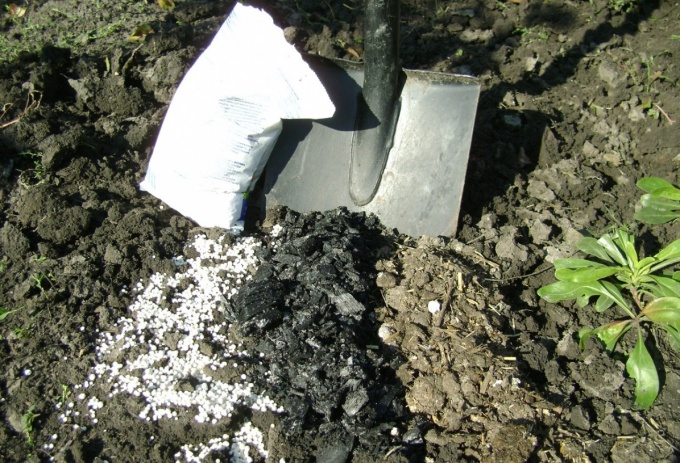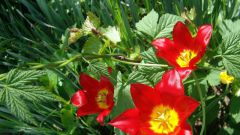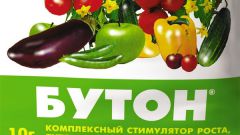Preparation of the soil
First, cleanse the area from crop residues, weeds, and then if you want to fertilize, they are uniformly close up — scatter across the surface and dug it to a depth in the range of 22-27 cm, given the depth of humus horizon of soil.
Seeds of flower and ornamental plants mainly small. If due to poor soil preparation , the seeds will fall to great depths, they rise raggedly, as most of the seedlings unable to penetrate the thick layer of soil and will die. The result will be uneven, sometimes very sparse germination.
After a rain or irrigation on the soil crust is formed, which hinders the gas exchange. In addition, dense soil crust dries quickly. Shallow cultivation breaks the soil crust, destroyed weeds, and result in better moisture remains. Especially adversely affected by the presence of a soil crust on emergence of small-seeded plants. Tillage is at a depth of 5-6 cm manual rippers.
For a good development of the flower plants it is necessary to improve the physical properties of the soil. The need of plants in varying mixes connected with his biological features. Soil mixture is a product of decomposition of grass, leaves, manure, peat, and other components that contain large amounts of organic matter, and characterized by better physical and chemical properties.
Usually harvested turf, leaf, humus and peat land. The first of these, heavy, elastic, porous, and rest easy.
Fertilizing
Ornamental plants respond well to the application to soil of fertilizers. After fertilisation the flowers become large, bright, considerable time retain their freshness. For plants the best fertilizer is manure. It activates the microbial activity of the soil, improves soil structure. The average rate of payment under annual plant 2-3 kg, under long-term — 6-9 kg / sq. m. When it is necessary to use the manure of the second or third year of decomposition, fresh manure the first year of decomposition is not recommended.
In addition to manure as organic fertilizer you can use valley (black) peat, bird droppings and compost.
Very effective in feeding plants with organic fertilizers. Liquid organic fertilizer can be prepared from mullein or chicken manure. In a barrel or bucket on a quarter of the volume put fresh mullein, the brim and top up with water and stirred well. The resulting solution is diluted before use with clean water 6-8 times.
Fertilizer of chicken manure contains significantly more nutrients than fertilizer mullein.
Before feeding plants first, sprinkled them with water and between plants, make furrows with a depth of 4-5 cm, and then they poured liquid fertilizer, and once it is absorbed, the grooves covered with earth. Such feeding is carried out once a week or 10 days. When feeding plants during the formation of buds and flowering it is recommended to add 4-5 g of superphosphate per litre of solution.
Special rules supplements: liquid fertilizers are applied after a rain or after a heavy watering with clean water; do not feed with liquid fertilizer during hot weather; only fertilize established plants, liquid fertilizer should not get on the leaves of plants, constant fertilizing perennials is in late July.
Great local fertilizer — ash, which contains easily digestible form of potassium and phosphorus. It possesses alkaline properties, it is typically used in acidic soils at 25-50 g per 1 sq. m. Widely used in floriculture also mineral fertilizers. Fertilizer is a chemical substance which contains one, two or more mineral elements for plants in a certain percentage.
Per 100 g or 100 kg of mineral fertilizers can contain 20 percent or more of the useful active substance, the remainder component or ballast. For example, 100 kg of urea contains 46 kg of pure nitrogen and 54 kg of the component. In practice, the amount of applied fertilizer in soil can be expressed in the physical weight or translation into a useful active substance. In the first case, this quantity is called the norm, and the second dose.
Of nitrogen fertilizers are widely used urea, ammonium nitrate, ammonium sulfate and others. Nitrogen fertilizers promote growth of stems and leaves. Rich fertilizer they typically delays zazulenii plants or they are affected by fungal diseases. All nitrogen fertilizer, easily soluble in water, applied to the soil shortly before sowing or use as top dressing during growth, before they are dissolved in water. In practice, in 10 liters of water dissolve a certain amount of nitrogen fertilizer, then spend feeding solution is based approximately 15-20 g fertilizer active ingredient per square meter.
Phosphate fertilizers are of great importance for early abundant and long flowering plants. They are required by all plants flower in any soil.
Phosphorus fertilizer is recommended to make under digging, before planting, and fertilizing. Of course, most of them need during the flowering period of plants. Almost all sparingly soluble, especially phosphate rock. Many phosphate fertilizers are acidic, so they should be paid in acidic soil only after the liming. For feeding it is recommended that superphosphate is a relatively well soluble fertilizer.
Most commonly used in horticulture potassium fertilizers: potassium salt, potassium sulfate, potassium chloride. They affect cold resistance and growth of plants along with phosphorus fertilizer had positive effect on flowering plants. Better to amend the soil in advance, in the fall.
In addition, the soil can be made complex fertilizers (nitrophoska, ammophos, NPK, and others), within which there are two or three elements of nutrition (nitrogen, phosphorus, potassium).
The percentage content of nutrients in the fertilizer is indicated in the passports, which are attached to the container.
Along with fertilizer soil in creating a normal environment for the growth and development of plants plays an important role in the calcium content of the soil. When it in the soil is small, the soil becomes sour and the plants not grow. Therefore, it is recommended to apply lime 1-2 kg per sqm.
For normal development and growth of plants is also required in the soil trace elements boron, manganese, zinc, molybdenum, cobalt and others. With a lack in the soil of any minerals not only reduced the vegetative mass of plants, but also deteriorates the quality of their flowers. Usually they make the soil much less. However, they give a good effect only when the soil is well provided with nitrogen, phosphorus, potassium and others. The rate of soil also usually specified in the passport package.


